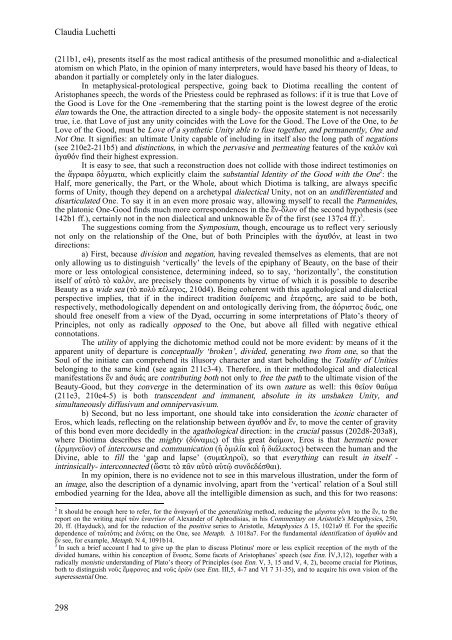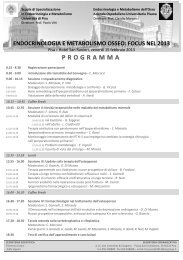You also want an ePaper? Increase the reach of your titles
YUMPU automatically turns print PDFs into web optimized ePapers that Google loves.
Claudia Luchetti<br />
(211b1, e4), presents itself as the most radical antithesis of the presumed monolithic and a-dialectical<br />
atomism on which Plato, in the opinion of many interpreters, would have based his theory of Ideas, to<br />
abandon it partially or completely only in the later dialogues.<br />
In metaphysical-protological perspective, going back to Diotima recalling the content of<br />
Aristophanes speech, the words of the Priestess could be rephrased as follows: if it is true that Love of<br />
the Good is Love for the One -remembering that the starting point is the lowest degree of the erotic<br />
élan towards the One, the attraction directed to a single body- the opposite statement is not necessarily<br />
true, i.e. that Love of just any unity coincides with the Love for the Good. The Love of the One, to be<br />
Love of the Good, must be Love of a synthetic Unity able to fuse together, and permanently, One and<br />
Not One. It signifies: an ultimate Unity capable of including in itself also the long path of negations<br />
(see 210e2-211b5) and distinctions, in which the pervasive and permeating features of the καλὸν καὶ<br />
ἀγαθόν find their highest expression.<br />
It is easy to see, that such a reconstruction does not collide with those indirect testimonies on<br />
the ἄγραφα δὀγµατα, which explicitly claim the substantial Identity of the Good with the One 2 : the<br />
Half, more generically, the Part, or the Whole, about which Diotima is talking, are always specific<br />
forms of Unity, though they depend on a archetypal dialectical Unity, not on an undifferentiated and<br />
disarticulated One. To say it in an even more prosaic way, allowing myself to recall the Parmenides,<br />
the platonic One-Good finds much more correspondences in the ἕν-ὅλον of the second hypothesis (see<br />
142b1 ff.), certainly not in the non dialectical and unknowable ἕν of the first (see 137c4 ff.) 3 .<br />
The suggestions coming from the <strong>Symposium</strong>, though, encourage us to reflect very seriously<br />
not only on the relationship of the One, but of both Principles with the ἀγαθόν, at least in two<br />
directions:<br />
a) First, because division and negation, having revealed themselves as elements, that are not<br />
only allowing us to distinguish ‘vertically’ the levels of the epiphany of Beauty, on the base of their<br />
more or less ontological consistence, determining indeed, so to say, ‘horizontally’, the constitution<br />
itself of αὐτὸ τὸ καλὸν, are precisely those components by virtue of which it is possible to describe<br />
Beauty as a wide sea (τὸ πολὺ πέλαγος, 210d4). Being coherent with this agathological and dialectical<br />
perspective implies, that if in the indirect tradition διαίρεσις and ἑτερότης, are said to be both,<br />
respectively, methodologically dependent on and ontologically deriving from, the ἀόριστος δυάς, one<br />
should free oneself from a view of the Dyad, occurring in some interpretations of Plato’s theory of<br />
Principles, not only as radically opposed to the One, but above all filled with negative ethical<br />
connotations.<br />
The utility of applying the dichotomic method could not be more evident: by means of it the<br />
apparent unity of departure is conceptually ‘broken’, divided, generating two from one, so that the<br />
Soul of the initiate can comprehend its illusory character and start beholding the Totality of Unities<br />
belonging to the same kind (see again 211c3-4). Therefore, in their methodological and dialectical<br />
manifestations ἕν and δυάς are contributing both not only to free the path to the ultimate vision of the<br />
Beauty-Good, but they converge in the determination of its own nature as well: this θεῖον θαῦµα<br />
(211e3, 210e4-5) is both transcendent and immanent, absolute in its unshaken Unity, and<br />
simultaneously diffusivum and omnipervasivum.<br />
b) Second, but no less important, one should take into consideration the iconic character of<br />
Eros, which leads, reflecting on the relationship between ἀγαθόν and ἕν, to move the center of gravity<br />
of this bond even more decidedly in the agathological direction: in the crucial passus (202d8-203a8),<br />
where Diotima describes the mighty (δύναµις) of this great δαίµων, Eros is that hermetic power<br />
(ἑρµηνεῦον) of intercourse and communication (ἡ ὁµιλία καὶ ἡ διάλεκτος) between the human and the<br />
Divine, able to fill the ‘gap and lapse’ (συµπληροῖ), so that everything can result in itself -<br />
intrinsically- interconnected (ὥστε τὸ πᾶν αὐτὸ αὑτῷ συνδεδέσθαι).<br />
In my opinion, there is no evidence not to see in this marvelous illustration, under the form of<br />
an image, also the description of a dynamic involving, apart from the ‘vertical’ relation of a Soul still<br />
embodied yearning for the Idea, above all the intelligible dimension as such, and this for two reasons:<br />
2 It should be enough here to refer, for the ἀναγωγή of the generalizing method, reducing the µέγιστα γένη to the ἕν, to the<br />
report on the writing περί τῶν ἐναντίων of Alexander of Aphrodisias, in his Commentary on Aristotle's Metaphysics, 250,<br />
20, ff. (Hayduck), and for the reduction of the positive series to Aristotle, Metaphysics Δ 15, 1021a9 ff. For the specific<br />
dependence of ταὐτότης and ἑνότης on the One, see Metaph. Δ 1018a7. For the fundamental identification of ἀγαθόν and<br />
ἕν see, for example, Metaph. Ν 4, 1091b14.<br />
3 In such a brief account I had to give up the plan to discuss Plotinus' more or less explicit reception of the myth of the<br />
divided humans, within his conception of ἕνωσις. Some facets of Aristophanes’ speech (see Enn. IV,3,12), together with a<br />
radically monistic understanding of Plato’s theory of Principles (see Enn. V, 3, 15 and V, 4, 2), become crucial for Plotinus,<br />
both to distinguish νοῦς ἔµφρονος and νοῦς ἐρῶν (see Enn. III,5, 4-7 and VI 7 31-35), and to acquire his own vision of the<br />
superessential One.<br />
298




